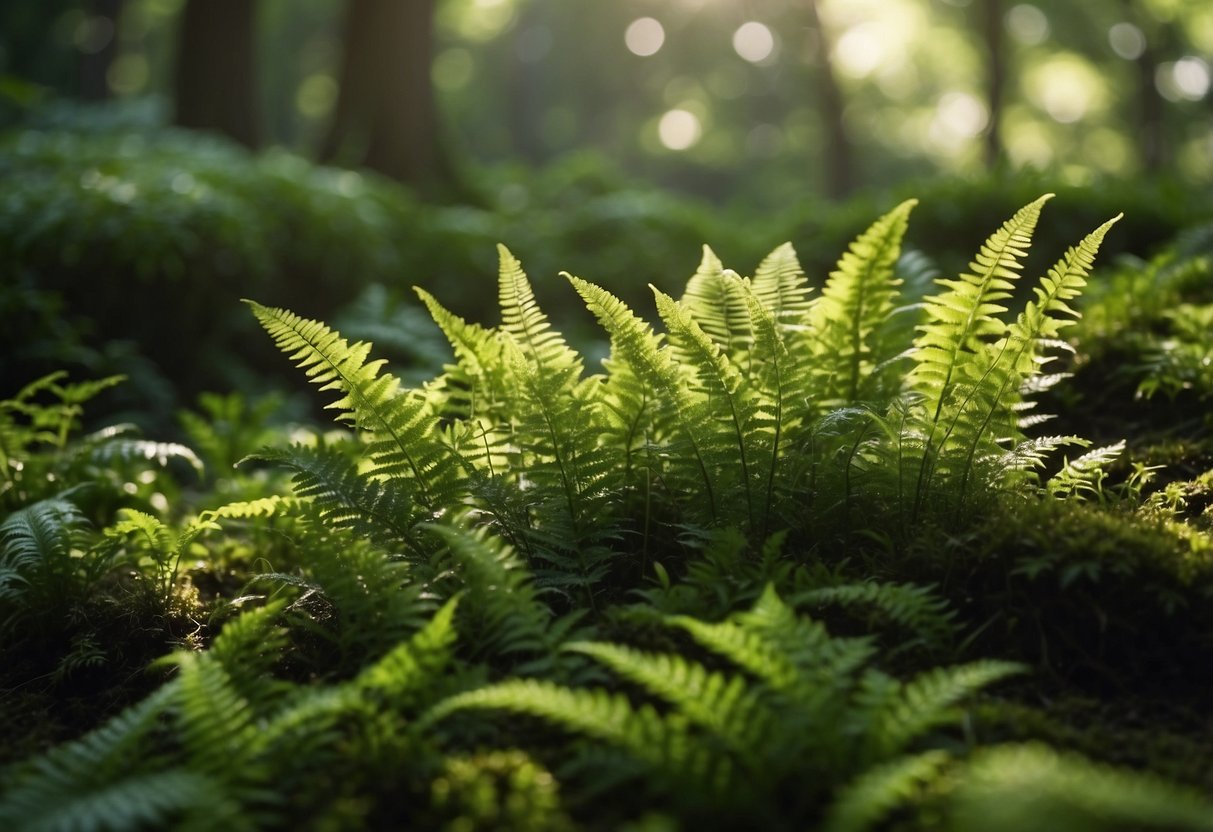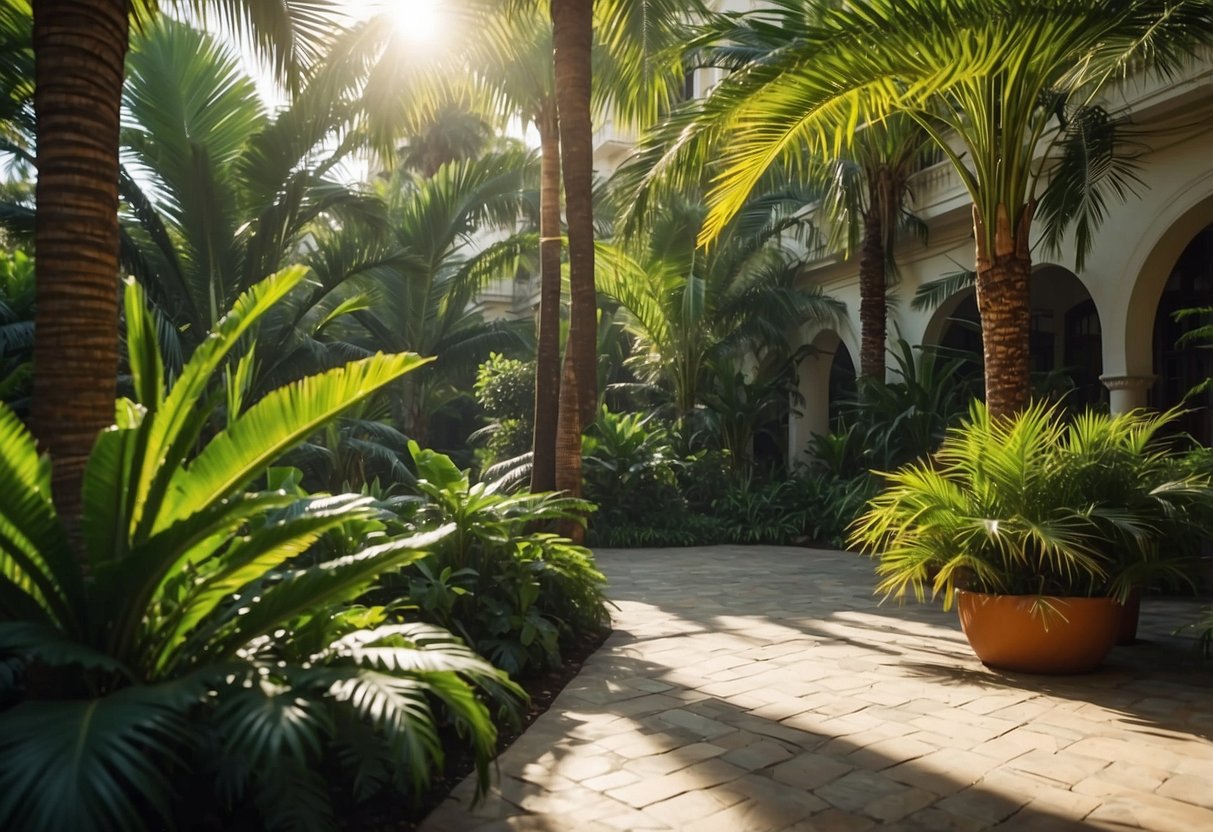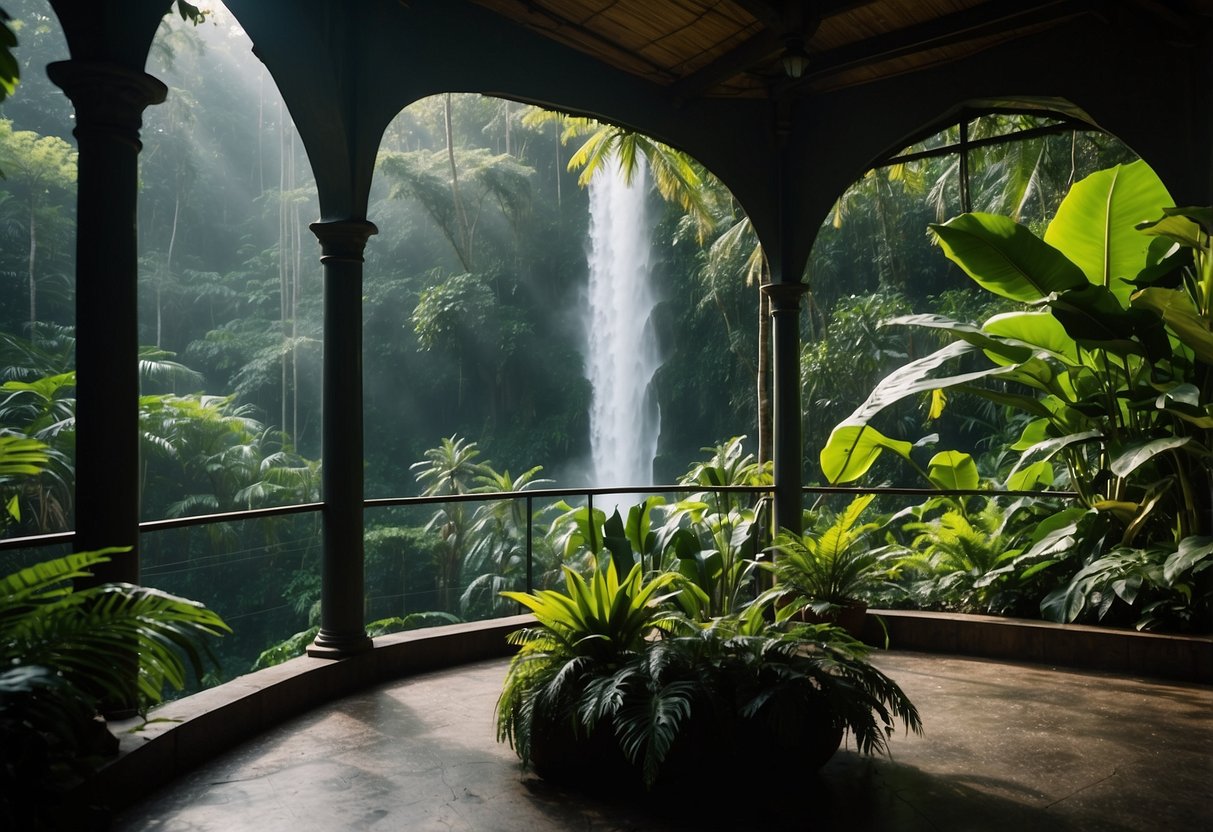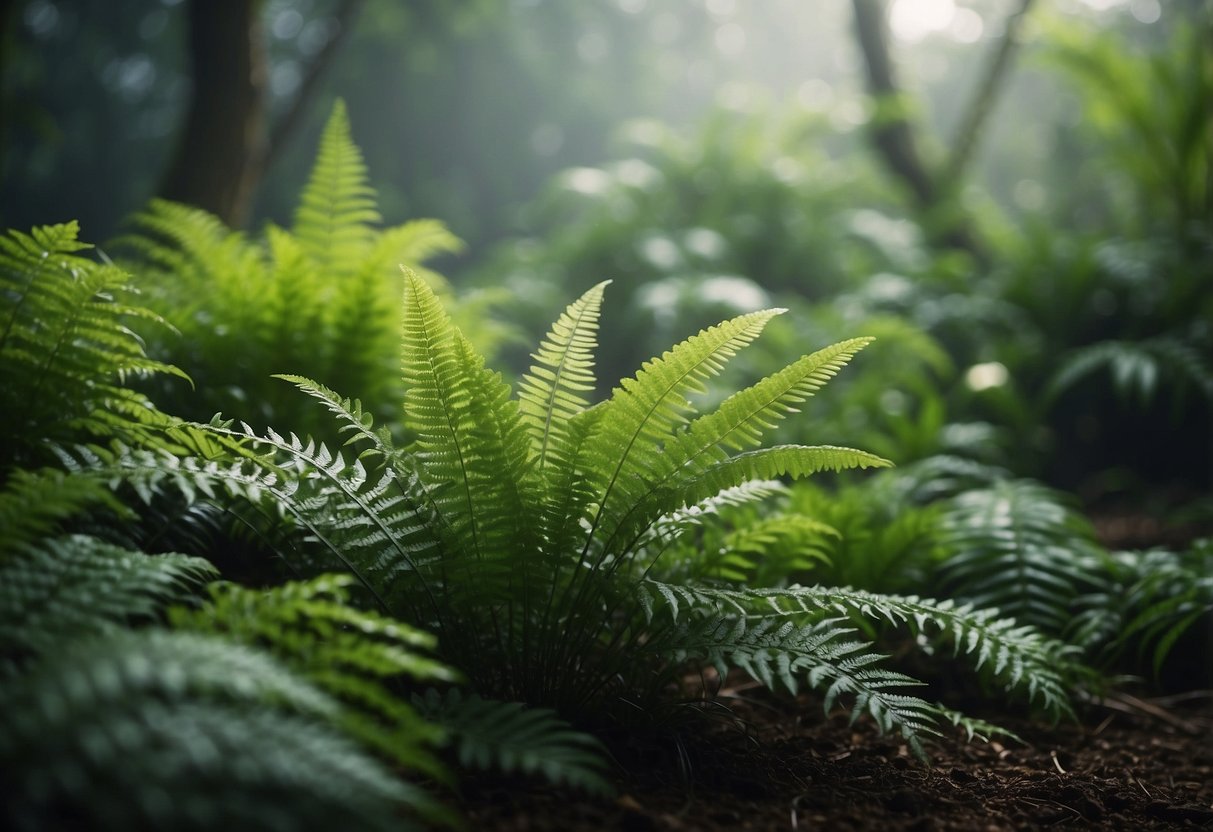Humid Garden Ideas: Lush Plants for Moist Climates
Gardening in humid climates presents unique challenges and exciting opportunities. The constant moisture and warmth can promote lush growth, but they also create the perfect environment for mold and mildew. Your garden can thrive by selecting the right plants and employing effective techniques.

How can you make the most of your humid garden space? By choosing plants that love humidity and implementing smart watering practices, you can create a beautiful, thriving garden. With a little planning, your garden can become a vibrant oasis, filled with colorful blooms and healthy greenery.
1) Misty Fern Garden

A misty fern garden can transform your backyard into a tranquil retreat. Ferns love humidity and do well in shaded spots.
Use a mix of different ferns like maidenhair and lady fern to create layers of texture.
Adding a mist system can help keep the air moist, which is ideal for ferns. This setup not only keeps your plants happy but also creates a calming atmosphere for you to enjoy.
2) Tropical Bamboo Haven

Creating a Tropical Bamboo Haven can transform your backyard into a lush retreat. Bamboo is a versatile plant that grows quickly and provides a natural privacy screen.
Place bamboo in clusters to create a dense, jungle-like atmosphere. It thrives in warm, humid climates, making it an ideal choice for your garden.
Incorporate pathways with bamboo edging for a cohesive look. Bamboo also pairs well with other tropical plants, adding layers and texture to your space.
Adding a bamboo grove creates a serene spot where you can relax and enjoy nature. Think of it as your personal tropical escape.
3) Lush Rainforest Retreat

Transform your backyard into a rainforest escape. Start by planting tall, leafy trees to create a canopy. Trees like palms and ferns can add that lush, green feel. Add layers underneath with colorful plants like bromeliads and orchids.
Incorporate water features like a small pond or waterfall. Use natural stones and pebbles for a more authentic look.
Include shaded spots by installing pergolas or using large leaves for cover. This creates cool resting areas, perfect for hot days.
4) Zen Waterfall Oasis

Imagine stepping into your backyard to find a Zen Waterfall Oasis. The sound of flowing water can calm your mind instantly.
Use natural materials like rocks and logs to create the waterfall. You can add some lush plants to enhance the serene feeling.
Choose a spot with a mix of sunlight and shade for the perfect balance. This creates a relaxing environment for meditation or simply unwinding.
Check out some inspiring ideas for a zen garden with a waterfall on SharonSable.
5) Fern and Moss Paradise

Creating a fern and moss paradise in your garden can turn it into a peaceful retreat. Ferns like the maidenhair fern and staghorn fern thrive in shady, humid areas. They add rich, layered textures to your space.
Mosses are ideal for filling in gaps and creating soft, green carpets. They grow well in damp, shady spots, making them perfect companions for ferns.
6) Vintage Pond Garden

A vintage pond garden can add charm to your space. You can use old-world elements like weathered urns and vintage terra cotta pots for a classic look.
Integrate aged wooden benches around your pond. These seating areas offer a place to relax and admire your garden.
Introduce old-fashioned plants like cosmos and verbena to enhance the nostalgic vibe of your garden.
7) Shady Palm Courtyard

A shady palm courtyard can be a perfect retreat from the sun. This kind of garden uses tall, leafy palms to create shade. Palms also add a tropical feel to your courtyard.
Consider adding ferns and hostas for extra greenery. These plants do well in shaded areas. Use mirror decor to make the space feel larger. You can also mix in low-maintenance succulents and bushes for variety.
Add seating areas to enjoy your palm courtyard. A bench or a few chairs can make it a cozy spot to relax.
8) Exotic Orchid Spring

Adding exotic orchids to your garden can create a magical atmosphere. These flowers come in various vibrant colors and unique shapes, making them a standout feature.
Hang orchids on walls or fences to save space and create a stunning look. Vertical gardening with orchids is both practical and visually appealing.
Consider using pots for your orchids. This allows you to easily move them around to find the best spot for their growth. Exotic orchids thrive in humid conditions, perfect for your garden. Discover more about these beautiful flowers at Thank Your Garden.
9) Tranquil Lily Pool

A tranquil lily pool can bring a sense of calm to your garden. Lilies, with their broad leaves and vibrant flowers, create a serene water feature.
Choose lilies that thrive in your climate and place them in the pool. Add a few small fish to help control insects.
Consider adding a stone bench nearby for a quiet place to relax. This will make the lily pool a peaceful retreat in your garden.
10) Steamy Jungle Alcove

Create a cozy, steamy jungle alcove in your garden by using dense, lush plants. Choose plants like ferns, palms, and elephant ears, which thrive in humidity.
Add a sitting area with a small bench or hammock. Use clay or decorative pots for your plants, adding visual interest.
Install shelves or stands to display plants at different heights. This creates a dynamic and visually appealing arrangement. Use saucers or trays under the pots for proper drainage and to catch excess water.
Understanding Humid Gardens

Humid gardens offer both unique advantages and specific challenges. Knowing how to manage these elements will help you cultivate a thriving garden.
The Benefits Of Humidity
Humidity can greatly benefit your garden. High moisture levels in the air reduce the need for frequent watering. This helps conserve water and allows plants to stay hydrated longer.
Certain plants, such as ferns, thrive in humid environments. They are naturally suited to these conditions and can grow lush and healthy. Plants like cinnamon fern are excellent choices for humid gardens, as they tolerate humidity and rainfall well.
Another benefit is that humidity supports quicker decomposition. This naturally enriches the soil with nutrients, making it more fertile for your plants.
Challenges In Humid Environments
Humidity can also create challenges for your garden. Fungal diseases are more likely to develop in wet conditions. Watering early in the day can help the foliage dry before evening, reducing this risk.
Mold thrives in hot, humid climates. Improve conditions by watering from below, not overhead, to keep leaves dry. Adequate air circulation and careful pruning are essential to prevent plant injury and mold growth.
Monitoring the soil is important to avoid overwatering. Although the air provides moisture, the soil may still need water during dry spells. Balance is key to keeping your plants healthy.
Plant Selection For Humid Gardens

Picking the right plants for a humid garden is crucial to ensure they thrive. Focus on varieties that can handle moisture and limited sunlight.
Best Plants For Humid Conditions
Bergenia: This plant, also known as “round-leaved saxifrage,” enjoys shady and humid environments. It has beautiful pink or white flowers in the spring and evergreen leaves that stay green all year.
Mahonia: This thorny shrub is great for shady areas. It has clusters of yellow flowers that attract pollinators and berries that birds love.
Sweet Potatoes: They grow attractive vines with purple flowers and need full sun to partial shade. Sweet potatoes are excellent if you want to grow vegetables in humid climates.
Blue Camassia: Known as the American hyacinth, this plant keeps pests like deer and rabbits at bay. It thrives in zones three through nine, making it versatile for humid areas.
Identifying Humidity-Loving Plants
When looking for suitable plants, search for those that are known to thrive in humid climates. Plants with large, waxy leaves often do well, as they can handle moisture better.
Consider ferns, begonias, and impatiens. Ferns are ideal because they love moisture and shade. Begonias and impatiens also do well in humid weather, adding vibrant colors to your garden.
Watering early in the day and ensuring good air circulation by spacing out your plants can help them manage the high humidity. Also, opt for well-draining soil to avoid waterlogging, which can harm the roots.
Knowing the specific moisture and sun needs of each plant helps you create a thriving and healthy humid garden.
Maintaining Humid Gardens

In humid gardens, managing water and preventing pests are crucial. Here’s how you can keep your garden healthy and thriving.
Watering Techniques
Watering your plants correctly is essential. In humid environments, it is best to water early in the day. This allows the foliage to dry out before evening, reducing the risk of fungal diseases. Always water at the base of the plants rather than from above to keep leaves dry.
Use a drip irrigation system or soaker hoses for precise watering. These tools help deliver water directly to the roots, ensuring that the water goes where it’s needed most. Regularly check the soil moisture to avoid overwatering, which can lead to root rot.
Maintaining good air circulation is also important. Space out your plants to allow air to flow freely between them. This helps keep the soil surface dry and reduces the chances of mold growth.
Pest Control In Humid Areas
Humid climates can attract various pests. Keeping pests under control requires vigilance and the right strategies. First, inspect your plants regularly for any signs of infestation. Look for damaged leaves, holes, or any unusual spots.
Encourage natural predators like ladybugs and spiders to keep pest populations in check. They feed on many common garden pests and help maintain a balance in your garden’s ecosystem.
Use organic pest control methods whenever possible. Neem oil, insecticidal soaps, and diatomaceous earth are effective and eco-friendly options. Applying these treatments in the morning can prevent them from washing away during humid nights.
Keep the garden clean by removing dead leaves and debris and perform careful pruning to help prevent pest infestations. Sanitation is key to a healthy garden environment.







